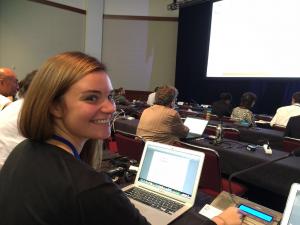UH Law School's environmental motions approved as World Conservation Congress resolutions
University of Hawaiʻi at Mānoa

UH law student Claire Colegrove reacts to the approval of Hawaii’s seven legal motions at the Congress.
In an exciting moment for Hawai‘i, all seven motions prepared by UH law students, in partnership with community environmental groups and agencies, have been approved and adopted as resolutions by the World Conservation Congress now under way at the Hawai‘i Convention Center.
Actions by the Congress of the International Union for Conservation of Nature (IUCN) are the early stages of creating international law -- by forging a consensus, and creating global precedent for nations to follow for global protection of the environment.
Today, in ‘en bloc’ voting during the Assembly portion of the WCC, all seven motions were adopted as resolutions before a global audience. More than 9,200 delegates from 192 countries are on hand for the Congress, which has been called the “Olympics of the Environment.”
“This is an exhilarating experience for the UH Law School, for our community partners and for the whole state,” said Associate Law Dean Denise Antolini, whose “Motions Class” at the William S. Richardson School of Law at UH developed the motions over three semesters in partnership with state agencies and environmental organizations. “All of the Hawai‘i-focused motions were approved by hundreds of IUCN members (in pre-Congress voting over the summer), and three of the motions were approved 100 percent by all states/countries voting.”
The IUCN announced approval of all seven motions on the eve of the opening of the Congress on September 1, after a summer of global pre-voting, but their passage as resolutions wasn’t official until today.
The three motions with unanimous pre-Congress votes were:
- Calls for global action and regional approaches to tackle the problem of marine debris (Motion 52).
- Community-based natural resource management (Motion 71).
- Aloha + Challenge Model for sustainable development (Motion 72).
The remaining four that also passed by wide margins during pre-Congress voting involve:
- Actions to curb biofouling (bringing new marine organisms to Pacific waters (Motion 51).
- Support of a Pacific region climate resiliency action plan combatting climate change (Motion 60).
- Indigenous peoples’ involvement in key IUCN organizations and programs (Motion 83).
- Validation of the importance of environmental courts (Motion 85).
The motions were seven of 86 debated during the electronic vote process and proposed for attention by the World Conservation Congress of the IUCN, which opened September 1 in elaborate ceremonies at Blaisdell Center, and is continuing through September 10 at the Hawai‘i Convention Center.
Attendees from around the globe, including heads of state and other high-level government officials, are wrestling with critically important environmental issues involving everything from climate change and resource management to illegal poaching of endangered species. “Our planet is at a Crossroads,” Hawai‘i Governor David Ige told attendees in his address to the Congress on opening day, and that concern has been echoed repeatedly by other speakers throughout the gathering.
This is the first time in the more than 70-year history of the global organization that it has held a Congress in the U.S.
The international gathering has been of special significance to law students who have attended the daily sessions, and may well be among those dealing with environmental issues through their law careers. For the past two decades, the Environmental Law Program at UH Law School has been an important training ground for students interested in environmental concerns both locally and globally.
“This affirms the critically important work of our law students as emerging leaders on the global stage,” said Antolini. “Having the International Union for Conservation of Nature in Hawai‘i gives us a once-in-a-lifetime opportunity to create the new cohort of Richardson lawyers engaging in international conservation for years to come.”
As well as being integrally involved in the development of the Hawai‘i motions, UH law students have formed partnerships with other IUCN members to support motions to protect Pacific regions. The Environmental Law Program at the UH Law School, directed by David Forman, is a voting member of the IUCN. Law students focusing on environmental issues have been at the Congress daily and will be engaging directly in floor debate from September 6-10 on the remaining 14 motions slated for full Assembly discussion as part of the work of the Congress.
Emily Gaskin ‘17, who led the effort to draft Hawai‘i’s marine debris motion, noted that the significance of this issue was elevated when the Richardson motion was merged with a similar motion proposed by the Government of Australia. “We were honored to be placed on the same platform with Australia,” said Gaskin. As a result, the UH students formed a strong working relationship with Australia to push the critical oceans issue forward at the Congress.
Said Richardson Law Dean Avi Soifer, “This effort embodies the collaborative approach of the Law School’s Environmental Law Program and illustrates why Richardson is so much admired not only throughout Hawai’i but around the globe.”
In reflecting on passage of the seven Hawai‘i motions as resolutions, law student Jennifer Eick ’18 said that the action “sets a great precedent for our involvement with the IUCN.
“The class worked so hard to learn the process of what being members of the IUCN means,” said Eick. “It’s just upward from here; having a larger partnership (with the IUCN) is to come. I just think, how lucky are we in Hawai‘i to have this Congress here."
For more information, visit: https://www.law.hawaii.edu/
